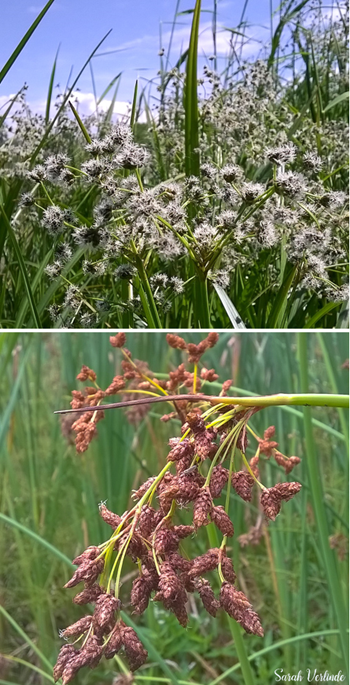Small-fruited bulrush
Scirpus microcarpus – Small-fruited bulrush
At a Glance:

- Family: Cyperaceae
- Plant Type: Tall herbaceous, grass-like plant that spreads rhizomatously, sending out single to few shoots at a time.
- Distribution: Widespread across most of North America, Pacific Coast to New England
- Habitat: Wetlands, ditches, and moist areas at low to mid-elevations
- Height: 0.5 -1.5m tall
- Flower/Fruits: Terminal cluster of flowers, appearing white at peak bloom. Fruits develop to smooth red-brown scales covering a small straw-colored seed.
- Flowering Season: June-August
- Leaves: Fertile culms (flowering stem) are triangular in cross-section. Leaves are green and grass-like, with a red-purple tinted sheath.
- Generation: Perennial
- Notable feature: Scirpus cyperinus can be distinguished from S. microcarpus because of it’s very wooly hairy bristles covering the seed/achene.
Restoration and Conservation
Excellent plant to use in revegetation of freshwater shorelines and to stabilize soil. Tall stems along shoreline provide birds nesting areas and shelter.
Ethnobotany
The root and stems have been harvested by Native Americans and eaten raw or cooked. The pollen, like cattail pollen, is rich in protein and has been added to other flours and used in baking. The long stems were also used for basket weaving and woven decoration on clothing items.
References and Resources
- King Co: https://green2.kingcounty.gov/gonative/Plant.aspx?Act=view&PlantID=102
- PFAF: https://pfaf.org/user/Plant.aspx?LatinName=Scirpus+microcarpus
- WTU Image Herbarium: http://biology.burke.washington.edu/herbarium/imagecollection/taxon.php?Taxon=Scirpus%20cyperinus
This article was written by Sarah Verlinde. For questions regarding the UWB/CC Plant Tour, contact Sarah at severlin@uw.edu.